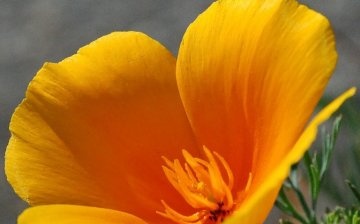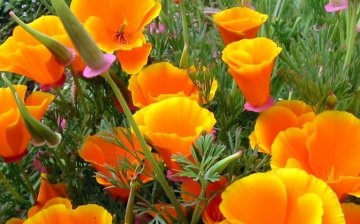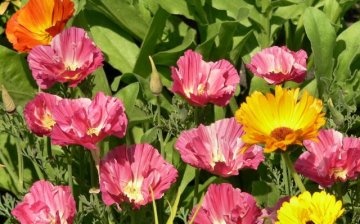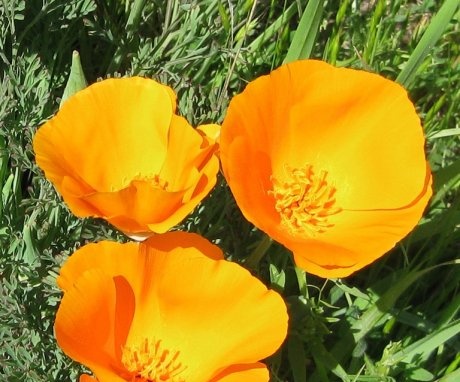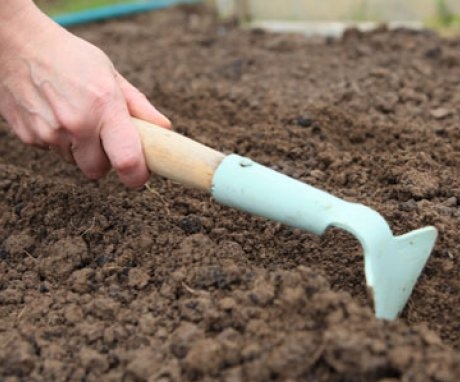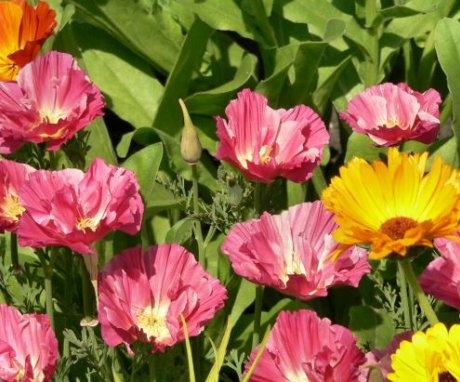Escholzia: growing from seed and caring for the plant
Escholzia is a plant of extraordinary beauty, belonging to the poppy family. It grows low, only about 40 cm. The leaves are deeply dissected, and the flowers are usually orange or red. The root system is pivotal, penetrates deep into the ground. It gets along well on loose fertile soils. The plant is very resistant to drought. The plant is photophilous, therefore the flowers open only in the daytime in the sun.
Content:
Escholzia characteristic
Aescholzia was originally described by the Scottish surgeon and botanist A. Menziez on the Pacific coast around 1781-1795. He collected and brought seeds to Europe, but they never grew. October 1816 was marked by the arrival of a Russian expedition to the San Francisco Bay, commanded by the young lieutenant Otto F. Kotzebue. Two naturalists also took part in this expedition - botanist Adelbert f. Chamizzo and zoologist Johann Friedrich f. Eschsholtz.
The first, upon returning to Europe, was able to grow more than 30 species of seeds he collected, among which there were Californian poppies. He accompanied his own descriptions with colorful images. He named one type of poppy after his close friend the zoologist. This is how the "eschscholzia" came about.
Another name of the plant - "Californian poppy" has taken root well among the people.
Escholzia is very popular in its homeland. The flowers of the California poppy were honored to adorn the coat of arms of California, where it is considered the most real gold.
Even beginner flower growers will be able to grow escholziawho have just got acquainted with floriculture. All thanks to her unpretentious nature. No wonder this plant was nicknamed the Californian poppy. This romantic flower has managed to retain its wild appearance. Despite the sunny origin of Escholzia from distant California, it perfectly takes root on personal plots and in regions with a temperate climate. Small flowers of the plant resemble beautiful butterflies, they diversify the flower bed, decorating it with a variety of their juicy colors. It is thanks to this palette of colors that Escholzia is becoming more and more popular among flower lovers.
Plant care
Growing escholzia is not only fun, but also not difficult. Due to the fact that she loves warmth and light, she can withstand both long periods of drought and the first light frosts. The color is also appreciated for the fact that it blooms for a relatively long time: from June to the very autumn. The fruits are represented by capsules, appear a month after the end of flowering.
The plant can grow well even on sandy soils. Do not plant it on acidic, fertilized with fresh manure or damp soils. Otherwise, the plant will simply die. Dampness and shade are not the best companions for an escholzia. The root system must be provided with aeration. At the place where the escholzia grows, water should not stagnate. In general, the planting site should meet all the requirements of the culture.
Escholzia is grown from seeds. Seeds are stored for no more than three years, after which the percentage of germination will be reduced.
Due to the fact that the root system of the escholzia is quite long, then the plant is planted directly into the soil, it is better to avoid transplants. It is possible to plant an escholzia under glass.
The first shoots will sprout in two weeks. After the formation of four leaves, the plant can be thinned out. An adult escholzia can grow to a height of about 60 cm. And after a while it will take up the entire flower garden. After the bolls have ripened, the seeds spill out, and self-sowing is carried out. This helps to renew the escholzia multiple times in the same area over the course of several years.
The beginning of summer can be marked by damage to the leaves of bean aphids, which will help to fight various treatments.
In addition to aphids, a spider mite may appear. It usually appears in dry, hot weather. In this case, you will have to remove the affected flowers. Such a disease of plants is still common when they turn yellow and thin out. They will need to be removed to ensure the safety of other bushes. The plant is very unpretentious, it does not require complicated care, and, moreover, it gives true pleasure with its flowering.
In general, care is as follows:
- Choosing the right landing site.
- Timely watering. Plants need to be watered in the evening.
- Fertilizers. Mineral fertilizers will be effective. Fertilizing is necessary before the flowering phase.
- Escholtia treatment for parasites.
- Shrub pruning.
Perennial varieties of Escholzia can be grown as one- and biennial plants. In the fall, before the onset of the first frost, you can dig up a bed of Escholzia and remove the remnants. With the onset of spring, new strong shoots will begin to break through. They will need to be thinned out, fertilized with organic fertilizers, and after a month you can enjoy the splendor of this plant. It turns out that planting this plant is not a particularly difficult process, and special care is not required at all.
Growing from seeds
Escholzia propagates exclusively with the help of seeds:
- The seeds ripen in capsules and are harvested after the plant has faded. The boxes open with a bang and the seeds spill out. If you remove the boxes during the time, you can increase the flowering of the plant and the attractiveness of your flower garden.
- For three years, the seeds are able to remain viable.
- Escholzia has a long rod system, which is very inconvenient for transplanting. Therefore, planting escholzia is carried out immediately in the beds or peat pots, only so as not to damage the roots. The pots then have to be planted in the beds next to the plants.
- Small seeds of the plant are planted in the beds in early spring. The bed should be watered periodically and certainly mulch... Otherwise, the seedlings are ways and not to break through the dry crust of the earth that forms after watering.
As mentioned above, the plant sprouts two weeks after planting, and when 4-5 leaves appear, the plants need to be thinned out. At the same time, a distance of about 20 cm should remain between the shoots. Before the flowering phase, the escholtia is fed with fertilizers.
Varieties and types of escholzia
There are over 120 species and even more forms of escholzia that grow in North America. Florists most often use only three species that came from the west of North America, namely California.
The most popular types of escholzia:
- Eschsholzia Lobba is a small, one might even say, tiny plant. It grows in height by only 13-18 cm, and its diameter does not exceed 15 cm. The flowers are small in size, light yellow or yellow in color. The flowering stage begins in June and ends in late September.
- Eshsholzia turfy is a small plant, about 15 cm. Eshsholzia has the shape of a dense bush. The leaves of the plant have a subulate shape and are collected in an inflorescence of a rosette, on which there are a large number of yellow flowers. Flowering begins in July and lasts until the end of autumn.
- Californian Eschsholzia is the best annual plant that can be easily and simply grown in your own garden. Culture dates back to the distant 1970th year. The plant blooms in the form of a branchy shrub that practically spreads along the ground. Plant height from 20 to 50 cm. Almost all shoots originate in the root collar. Plants look incredibly beautiful. The stem is graceful, slender and fragile. The leaves are arranged on long petioles, gather in a rosette near the root. Escholzia flowers are like poppy flowers. The flowers are usually brightly colored pink, red, yellow, purple, etc.
The bud is usually covered with a cap, which he sheds in the morning when it opens. The flowering phase of this type of escholzia is long and stable. It blooms from the very beginning of June until the end of autumn.
The buds open exclusively on sunny days, which again confirms the fact of the plant's love for light.
Californian escholzia has many different varieties. The following varieties are especially popular:
- Golden Orange - has beautiful orange flowers.
- Ballerina - semi-double, pale pink flowers.
- Anshantre - double, pink flowers.
- Golden Glorry - flowers are painted bright yellow.
- Mandarin - these flowers are non-double, orange in color.
- Mikado is bright orange in color.
- Milky White - flowers of an unusually beautiful cream color.
- Red Chief is red.
- Feuerflame - large flowers of orange and dark red color.
- Apricot Chiffon - this variety has leaves painted in a beautiful aqua color.
All of the above varieties and types of escholzia love warmth, tolerate cold and even small frosts down to -5 degrees. They can be resistant to dry weather, but a prolonged lack of moisture in hot weather can affect a decrease in flowers and a loss of decorativeness. In shady areas, the plants grow poorly, the stems become very elongated and lose all their beauty. Plants are undemanding to the type of soil. Plants are susceptible to viral diseases.
More information can be found in the video.



